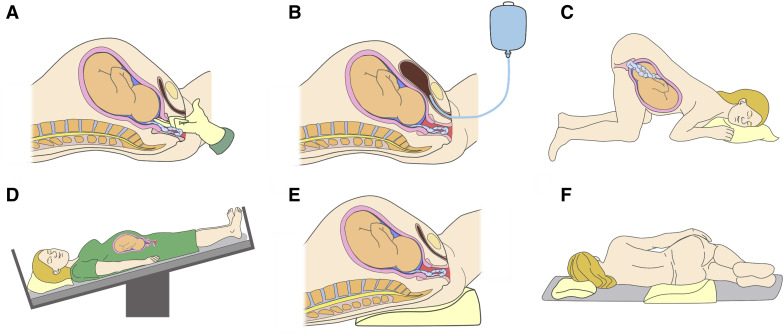A nurse is caring for a client who is in labor and has spontaneous rupture of membranes. The nurse notes that the umbilical cord is protruding from the client's vagina. After calling for help, which of the following actions should the nurse take first?
Use fingers to exert upward pressure on the presenting part
Administer a tocolytic medication
Wrap the cord in a sterile towel and moisten with warm sterile normal saline
Apply oxygen via facemask to the client
The Correct Answer is A
A. Use fingers to exert upward pressure on the presenting part
The priority in the case of a prolapsed umbilical cord is to relieve pressure on the cord to maintain blood flow to the fetus. The nurse should use sterile-gloved fingers to lift the presenting part of the fetus off the prolapsed cord. This action helps prevent compression of the umbilical cord, which could lead to fetal hypoxia and distress.
B. Administer a tocolytic medication: Tocolytic medications are used to inhibit uterine contractions. While tocolytics might be used in certain situations, the immediate concern with a prolapsed cord is to relieve pressure on it to maintain fetal blood flow.
C. Wrap the cord in a sterile towel and moisten with warm sterile normal saline: While covering the cord with a sterile towel and moistening it can help prevent drying and protect the cord, it is not the first priority. The primary concern is relieving pressure on the cord to prevent fetal compromise.
D. Apply oxygen via facemask to the client: Oxygen administration is important in managing fetal distress, but it is not the first action to take in the case of a prolapsed umbilical cord. The priority is to relieve pressure on the cord to maintain fetal oxygenation.

Nursing Test Bank
Naxlex Comprehensive Predictor Exams
Related Questions
Correct Answer is B
Explanation
A. Urinary output 40 mL/hr: Decreased urinary output can be an indicator of inadequate fluid intake or other issues, but it is not a specific sign of hemorrhage.
B. Blood pressure 88/40 mm Hg: This is the correct answer. A low blood pressure, especially with a low diastolic pressure, can be indicative of hypovolemic shock, which may result from postpartum hemorrhage. Hemorrhage leads to a decrease in circulating blood volume, causing a drop in blood pressure.
C. Moderate rubra lochia: Lochia is the normal vaginal discharge experienced after childbirth, and moderate rubra lochia is considered within the expected range for the early postpartum period. It is not a specific sign of hemorrhage.
D. Heart rate 90/min: A heart rate of 90 beats per minute is within the normal range for a postpartum client and may not be a specific sign of hemorrhage. However, an increase in heart rate could be an early indicator of hypovolemia due to hemorrhage.
Correct Answer is B
Explanation
A. The client cleans the perineum with a squeeze bottle after urinating: This action is appropriate for postpartum perineal care. Using a squeeze bottle to cleanse the perineum with warm water after urination helps maintain cleanliness without causing trauma to the area.
B. The client is changing the perineal pad once daily: Changing the perineal pad once daily is not optimal for wound healing. Postpartum perineal wounds require frequent changing of pads to maintain cleanliness, prevent infection, and promote healing.
C. The client is using witch hazel pads on the perineum: Using witch hazel pads is a common practice for postpartum perineal care. Witch hazel has a soothing effect and can help reduce inflammation and discomfort without negatively affecting wound healing.
D. The client's perineal suture line is well-approximated: A well-approximated perineal suture line is a positive finding, indicating that the edges of the wound are properly aligned and closed, which supports the healing process.
Whether you are a student looking to ace your exams or a practicing nurse seeking to enhance your expertise , our nursing education contents will empower you with the confidence and competence to make a difference in the lives of patients and become a respected leader in the healthcare field.
Visit Naxlex, invest in your future and unlock endless possibilities with our unparalleled nursing education contents today
Report Wrong Answer on the Current Question
Do you disagree with the answer? If yes, what is your expected answer? Explain.
Kindly be descriptive with the issue you are facing.
